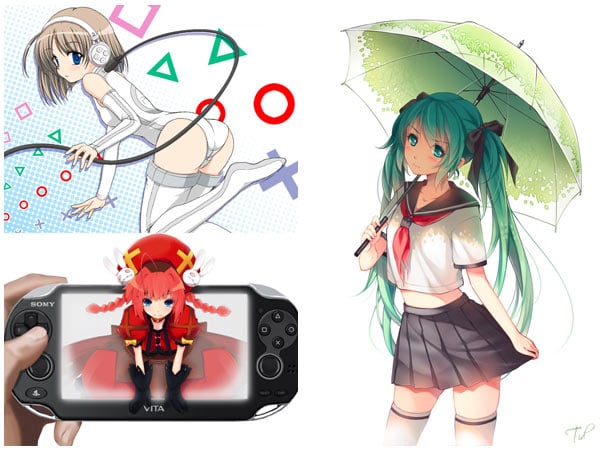
The holiday season continues, and people are eager to receive wonderful gifts, including one that Hatsune Miku (?) has for you. Remember, J-List is offering free shipping on all J-List anime and kanji T-shirts and shrinkwrapped visual novels shipping from San Diego, for the rest of the month!
It’s interesting to compare the evolution of Japan’s anime industry to other areas of Japanese pop culture, for example, its strong idol music scene. The word “idol” entered use in Japan in 1971 to describe the fast-growing industry of youthful, energetic pop stars. The idol industry went through many phases, including the “golden age” of 80s idols, the “Okinawa period” when stars like Amuro Namie and SPEED were everywhere, and the current age of massive bands like AKB48. SKE48 and E-girls, with many members. Idol culture first crossed over with anime in 1982 with Macross’ Lynn Minmei, the first “idol” who didn’t really exist, and this show is filled with in-jokes for fans of Matsuda Seiko and Nakamori Akina, popular singers of the era. Looking back, creating 2D idols in anime was as big an innovation as transforming mecha or computer coloring, given the success that would follow, from all the subsequent Macross series to Idolmaster to Love Live: School Idol Project (and less directly, Vocaloids). I’m a fan of 80s idol queen Matsuda Seiko, as is my Japanese wife, and earlier this week we were able to attend a Christmas Dinner Show with a live performance by our favorite singer.
Japan is a great place, filled with with wonderful people, beautiful nature views and lots of amazing foods like discover, like “aspara-bacon” (asparagus wrapped in bacon), a favorite dish of mine at izakaya restaurants. Still, because Japan is such a homogenous place, there are times when the country suffers from what I call the “tyranny of the majority,” not being understanding enough of people in unique situations. The Japanese think bread should be white and fluffy, so don’t expect to find a huge selection of non-white bread in supermarkets here. They also tend to like thick, creamy milk with 4.2% milkfat or higher, and it’s not uncommon to find no lowfat milk available in the store – and just forget about ever finding skim milk, if you need it for some reason. The Japanese often don’t “get” non-standard food lifestyles, and if you’re a vegetarian or a diabetic, or need to avoid rice or caffeine for health or religious reasons, it can be a lot of extra work. Historically Japanese companies haven’t been sensitive to people with food allergies, though this is finally starting to change. Another issue is Japanese assuming every foreigner is blonde haired and blue-eyed. If you happen to be nisei Japanese or have an Asian face that looks Japanese, you might find people speaking at you rapidly, not wondering why you don’t understand, or why you can’t write every kanji character.
Girlish Grimoire Littlewitch Romanesque is the awesome visual novel/bring-up simulation game from famed Japanese illustrator Oyari that we’ll be releasing in English soon. The Limited Edition of the game is unfortunately delayed due to a snag at the duplication factory, but never fear: we’ll be releasing the download edition of the game to all customers on Monday, December 22nd, and shipping the package versions out as soon as they come in. This is an amazing game with 100 spells to explore and 79 quests to complete as you train Aria and Kaya to be mages. Order the game now! Also: we’ve got a Steam Greenlight project for the all-ages version of the game, and we hope you’ll vote for us! (Steam keys will be provided to purchasers of the Limited Edition for free.)
















